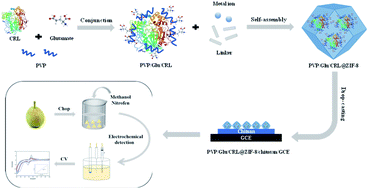Biomimetic self-assembly of lipase-zeolitic imidazolate frameworks with enhanced biosensing of protox inhibiting herbicides†
Abstract
Protox inhibiting herbicides such as nitrofen have detrimental effects on the environment and human health. The current work aims to fabricate a Candida rugosa lipase (CRL)-based electrochemical sensor for rapid and sensitive detection of protox inhibiting herbicides (nitrofen). We proposed the use of poly(vinylpyrrolidone) (PVP) and amino-acids to promote accumulation of Zn2+ ions at the surfaces of Candida rugosa lipase (CRL) and subsequently induce self-assembly of a CRL-zeolitic imidazolate framework (ZIF) structure. This process can be easily and rapidly achieved via a one-pot facile self-assembly method. Steady-state fluorescence spectroscopy indicated that CRL has undergone a conformational change following encapsulation within the ZIF structure. This conformational change is beneficial as the prepared PVP/Glu/CRL@ZIF-8 exhibited enhanced catalytic activity (207% of native CRL), and higher substrate affinity (lower Km than native CRL) and showed high stability under harsh denaturing conditions. PVP/Glu/CRL@ZIF-8 was finally used for electrochemical biosensing of nitrofen. The fabricated biosensor has a wide linear detection range (0–100 μM), a lower limit of detection and a good recovery rate.

- This article is part of the themed collection: Analytical Methods HOT Articles 2021


 Please wait while we load your content...
Please wait while we load your content...